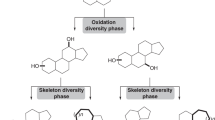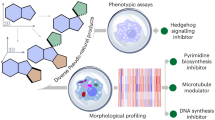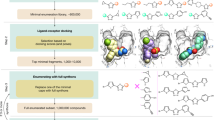Abstract
The structures and biological activities of natural products have often provided inspiration in drug discovery. The functional benefits of natural products to the host organism steers the evolution of their biosynthetic pathways. Here, we describe a discovery approach—which we term activity-directed synthesis—in which reactions with alternative outcomes are steered towards functional products. Arrays of catalysed reactions of α-diazo amides, whose outcome was critically dependent on the specific conditions used, were performed. The products were assayed at increasingly low concentration, with the results informing the design of a subsequent reaction array. Finally, promising reactions were scaled up and, after purification, submicromolar ligands based on two scaffolds with no previous annotated activity against the androgen receptor were discovered. The approach enables the discovery, in tandem, of both bioactive small molecules and associated synthetic routes, analogous to the evolution of biosynthetic pathways to yield natural products.
This is a preview of subscription content, access via your institution
Access options
Subscribe to this journal
Receive 12 print issues and online access
$259.00 per year
only $21.58 per issue
Buy this article
- Purchase on Springer Link
- Instant access to full article PDF
Prices may be subject to local taxes which are calculated during checkout




Similar content being viewed by others
References
Newman, D. J. & Cragg, G. M. Natural products as sources of new drugs over the last 25 years. J. Nat. Prod. 70, 461–477 (2007).
Beghyn, T., Deprez-Poulain, R., Willand, N., Folleas, B. & Deprez, B. Natural compounds: leads or ideas? Bioinspired molecules for drug discovery. Chem. Biol. Drug Des. 72, 3–15 (2008).
Wetzel, S., Bon, R. S., Kumar, K. & Waldmann, H. Biology-oriented synthesis. Angew. Chem. Int. Ed. 50, 10800–10826 (2011).
Maplestone, R. A., Stone, M. J. & Williams, D. H. The evolutionary role of secondary metabolites—a review. Gene 115, 151–157 (1992).
Firn, R. D. & Jones, C. G. Natural products—a simple model to explain chemical diversity. Nat. Prod. Rep. 20, 382–391 (2003).
Krier, M., Bret, G. & Rognan, D. Assessing the scaffold diversity of screening libraries. J. Chem. Inf. Model. 46, 512–524 (2006).
Wetzel, S. et al. Interactive exploration of chemical space with Scaffold Hunter. Nature Chem. Biol. 5, 581–583 (2009).
Renner, S. et al. Bioactivity-guided mapping and navigation of chemical space. Nature Chem. Biol. 5, 585–592 (2009).
Kishirsagar, T. (ed.) High-Throughput Lead Optimization in Drug Discovery (CRC, 2008).
Roughley, S. D. & Jordon, A. M. The medicinal chemist's toolbox: an analysis of reactions used in the pursuit of drug candidates. J. Med. Chem. 54, 3451–3479 (2011).
Cooper, T. W. J., Campbell, I. B. & Macdonald, S. J. F. Factors determining the selection of organic reactions by medicinal chemists and the use of the reactions in arrays (small focused libraries). Angew. Chem. Int. Ed. 49, 8082–8091 (2010).
Walters, W. P., Green, J., Weiss, J. R. & Murcko, M. A. What do medicinal chemists actually make? A 50-year retrospective. J. Med. Chem. 54, 6405–6416 (2011).
Lipkus, A. H. et al. Structural diversity of organic chemistry. A scaffold analysis of the CAS registry. J. Org. Chem. 73, 4443–4451 (2008).
Trabocchi, A. (ed.) Diversity-Oriented Synthesis: Basics and Applications in Organic Synthesis, Drug Discovery and Chemical Biology (Wiley, 2013).
Burke, M. D. & Schreiber, S. L. A planning strategy for diversity-oriented synthesis. Angew. Chem. Int. Ed. 43, 46–58 (2004).
Galloway, W. R. J. D., Isidro-Llobet, A. & Spring, D. R. Diversity-oriented synthesis as a tool for the discovery of novel biologically active small molecules. Nature Commun. 1, 80 (2010).
Umeno, D., Tobias, A. V. & Arnold, F. H., Diversifying carotenoid biosynthetic pathways by directed evolution. Microbiol. Mol. Biol. Rev. 69, 51–78 (2005).
Lewis, W. G. et al. Click chemistry in situ: acetylcholinesterase as a reaction vessel for the selective assembly of a femtomolar inhibitor from an array of building blocks. Angew. Chem. Int. Ed. 41, 1053–1057 (2002).
Hirose, T. et al. Observation of the controlled assembly of preclick components in the in situ click chemistry generation of a chitinase inhibitor. Proc. Natl Acad. Sci. USA 110, 15892–15897 (2013).
Mamidyala S. K. & Finn, M. G. In situ click chemistry: probing the binding landscapes of biological molecules. Chem. Soc. Rev. 39, 1252–1261 (2010).
Corbett, P. T. et al. Dynamic combinatorial chemistry. Chem. Rev. 106, 3652–3711 (2006).
Davies, H. M. & Morton, D. Guiding principles for site selective and stereoselective intermolecular C–H functionalization by donor/acceptor rhodium carbenes. Chem. Soc. Rev. 40, 1857–1869 (2011).
Padwa, A. & Weingarten, D. M. Cascade processes of metallo carbenoids. Chem. Rev. 96, 223–269 (1996).
Doyle, M. P. & Forbes, D. C. Recent advances in asymmetric catalytic metal carbene transformations. Chem. Rev. 98, 911–935 (1998).
Davies, H. M. L. & Beckwith, R. E. J. Catalytic enantioselective C–H activation by means of metal–carbenoid-induced C–H insertion. Chem. Rev. 103, 2861–2903 (2003).
Nadeau, E., Ventura, D. L., Brekan, J. A. & Davies H. M. L. Controlling factors for C–H functionalization versus cyclopropanation of dihydronaphthalenes. J. Org. Chem. 75, 1927–1939 (2010).
Davies, H. M. L., Matasi, J. J. & Ahmed G. Divergent pathways in the intramolecular reactions between rhodium-stabilized vinylcarbenoids and pyrroles: construction of fused tropanes and 7-azabicyclo[4.2.0]octadienes. J. Org. Chem. 61, 2305–2313 (1996).
Gao, W., Bohl, C. E. & Dalton, J. T. Chemistry and structural biology of androgen receptor. Chem. Rev. 105, 3352–3370 (2005).
Fang, H. et al. Study of 202 natural, synthetic, and environmental chemicals for binding to the androgen receptor. Chem. Res. Toxicol. 16, 1338–1358 (2003).
Gao, W. & Dalton, J. T. Expanding the therapeutic use of androgens via selective androgen receptor modulators (SARMs). Drug Discov. Today 12, 241–248 (2007).
Mitchell, L. H. et al. Rational design of a topical androgen receptor antagonist for the suppression of sebum production with properties suitable for follicular delivery. J. Med. Chem. 53, 4422–4427 (2010).
Tong, Y. Androgen receptor antagonists and uses thereof. PCT patent WO 2012119559 A1 (2012).
Gauthier, D., Dodd, R. H. & Dauban, P. Regioselective access to substituted oxindoles via rhodium-catalyzed carbene C–H insertion. Tetrahedron 65, 8542–8555 (2009).
Ozers, M. S. et al. The androgen receptor T877A mutant recruits LXXLL and FXXLF peptides differently than wild-type androgen receptor in a time-resolved fluorescence resonance energy transfer assay. Biochemistry 46, 683–695 (2007).
Kyranos, J. (ed.) High Throughput Analysis For Early Drug Discovery (Elsevier, 2004).
Cawse, J. N., Wroczynski, S. & Darchun, B. Y. Method for defining an experimental space and method and system for conducting combinatorial high throughput screening of mixtures. US patent 6,826,487 B1 (2004).
Espino, C. G., Fiori, K. W., Kim, M. & Du Bois, J. Expanding the scope of C–H amination through catalyst design. J. Am. Chem. Soc. 126, 15378–15379 (2004).
Acknowledgements
The authors acknowledge funding from the University of Leeds and from the EPSRC (for equipment). The authors also thank K. Krishenbaum, P. M. Levine (both New York University) and S. Bartlett (University of Leeds) for discussions.
Author information
Authors and Affiliations
Contributions
A.N. and S.W. conceived, designed and supervised the project. G.K. undertook the experimental work. A.N., S.W. and G.K. analysed the results and wrote the paper.
Corresponding authors
Ethics declarations
Competing interests
The authors declare no competing financial interests.
Supplementary information
Supplementary information
Supplementary information (PDF 2984 kb)
Rights and permissions
About this article
Cite this article
Karageorgis, G., Warriner, S. & Nelson, A. Efficient discovery of bioactive scaffolds by activity-directed synthesis. Nature Chem 6, 872–876 (2014). https://doi.org/10.1038/nchem.2034
Received:
Accepted:
Published:
Issue Date:
DOI: https://doi.org/10.1038/nchem.2034
This article is cited by
-
Photochemical single-step synthesis of β-amino acid derivatives from alkenes and (hetero)arenes
Nature Chemistry (2022)
-
Streamlining bioactive molecular discovery through integration and automation
Nature Reviews Chemistry (2018)
-
Expanding the medicinal chemistry synthetic toolbox
Nature Reviews Drug Discovery (2018)
-
Samarium(II) folding cascades involving hydrogen atom transfer for the synthesis of complex polycycles
Nature Communications (2018)
-
Directing evolution: the next revolution in drug discovery?
Nature Reviews Drug Discovery (2017)



